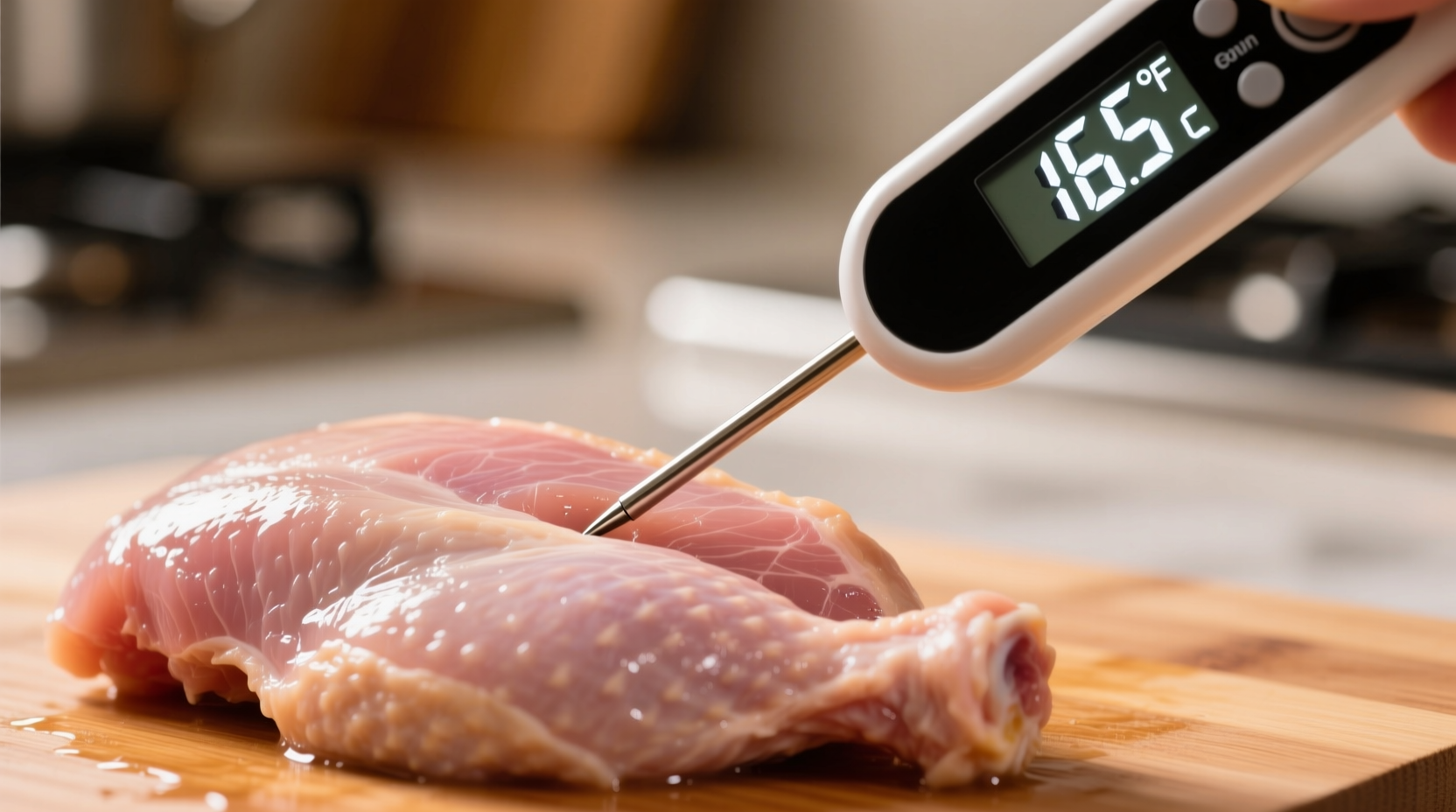Why Chicken Temperature Matters More Than You Think
Getting chicken temperature right isn't just about doneness—it's your primary defense against foodborne illness. Each year, USDA reports that undercooked poultry causes thousands of salmonella cases. But here's what most home cooks miss: temperature continues rising after removal from heat. Understanding this carryover cooking prevents dry, overcooked chicken while ensuring safety.
Your Step-by-Step Temperature Guide
1. The Critical Measurement Phase
Insert an instant-read thermometer into the thickest part of the meat, avoiding bones. For whole chickens, check both breast and thigh areas. Digital thermometers provide readings in 3-5 seconds—essential for accurate timing. Remember: visual cues like clear juices or firm texture cannot reliably indicate safety. The CDC confirms that 1 in 4 people believe chicken is done when it's still unsafe.
2. Understanding Temperature Zones
| Chicken Cut | Target Temp | Resting Time | Final Safe Temp |
|---|---|---|---|
| Chicken breasts | 160°F (71°C) | 5-8 minutes | 165°F (74°C) |
| Thighs & drumsticks | 165°F (74°C) | 3-5 minutes | 170°F (77°C) |
| Whole chicken | 160°F (71°C) | 10-15 minutes | 165°F (74°C) |
This strategic under-targeting leverages carryover cooking—the phenomenon where residual heat raises internal temperature 3-5°F during resting. Professional kitchens use this technique to achieve juicy results while meeting safety standards.
3. The Resting Period: Your Secret Weapon
That 5-15 minute rest isn't optional. During this time:
- Temperature equalizes throughout the meat
- Juices redistribute, preventing dryness
- Final pathogen destruction completes
Cover loosely with foil to retain heat without steaming the skin. Cutting too soon releases precious juices—wait the full recommended time.

Avoiding Common Temperature Traps
The color myth: USDA research shows fully cooked chicken can appear pink due to hemoglobin reactions, especially in younger birds. Color alone never indicates doneness.
The touch test fallacy: While experienced chefs use texture cues, food safety experts like those at FDA Food Code emphasize thermometers as the only reliable method. Muscle density varies by cut and cooking method.
Special Considerations for Different Cooking Methods
Grilling: High heat creates significant temperature gradients. Check multiple spots, especially where meat contacts grates.
Sous vide: At precise temperatures like 145°F (63°C) held for 30+ minutes, pasteurization occurs through time rather than peak temperature. Always sear afterward for food safety.
Slow cooking: Ensure your slow cooker maintains 140°F (60°C) or higher throughout the cooking process. The danger zone (40°F-140°F) allows bacteria growth.
What Happens Below 165°F?
At 150°F (66°C), salmonella requires 2.8 minutes for 7-log reduction. At 160°F (71°C), it takes just 14.2 seconds. The USDA's 165°F standard provides a critical safety buffer for home cooks who may not maintain exact temperatures. As USDA explains, this single temperature recommendation simplifies food safety for consumers.
Pro Tips for Perfect Chicken Every Time
- Calibrate your thermometer monthly using ice water (32°F/0°C) or boiling water (212°F/100°C)
- For bone-in cuts, insert thermometer between meat and bone
- When roasting whole birds, position thermometer in breast parallel to surface
- Keep a log of temperatures for different cooking methods to refine your technique
Frequently Asked Questions
Can chicken be safe at 160 degrees instead of 165?
Yes, but with critical conditions. At 160°F (71°C), chicken must maintain that temperature for at least 14.2 seconds to destroy pathogens. Most home cooks lack precise temperature control, so USDA recommends 165°F as a simpler, more reliable standard that accounts for temperature fluctuations during cooking.
Why does my chicken thermometer show 165 but the meat looks pink?
Pink color in properly cooked chicken occurs due to myoglobin reacting with air during cooking, especially in younger birds. Nitrites in feed or marinades can also cause persistent pinkness. Always trust your thermometer over visual cues—the USDA confirms color isn't a reliable doneness indicator.
How long after reaching 165°F should I let chicken rest?
Rest chicken for 5-8 minutes for boneless cuts and 10-15 minutes for whole birds or bone-in pieces. This allows temperature equalization and juice redistribution. During this time, the internal temperature typically rises 3-5°F, ensuring complete pathogen destruction while maintaining moisture.
Does oven temperature affect the required internal temperature?
No. Regardless of cooking method (baking, grilling, frying), the required internal temperature remains 165°F (74°C). Higher oven temperatures cook faster but don't change the safety threshold. The critical factor is the meat's internal temperature, not the cooking environment.











 浙公网安备
33010002000092号
浙公网安备
33010002000092号 浙B2-20120091-4
浙B2-20120091-4